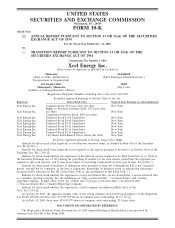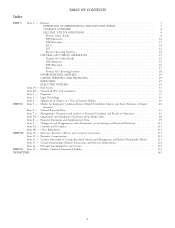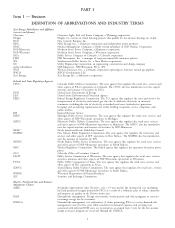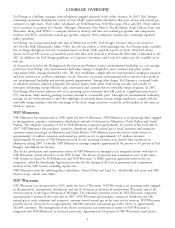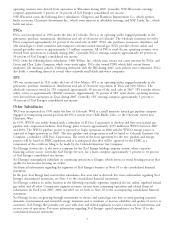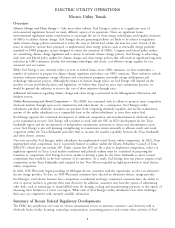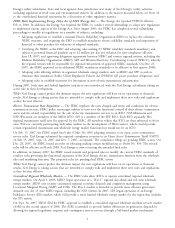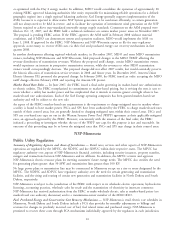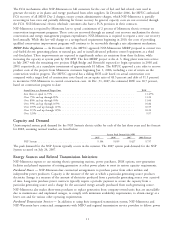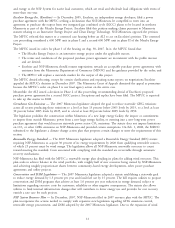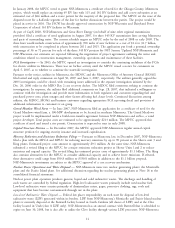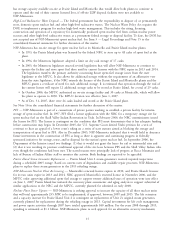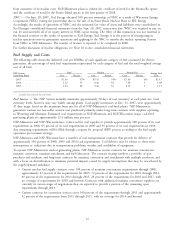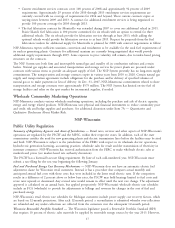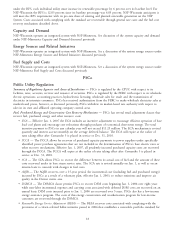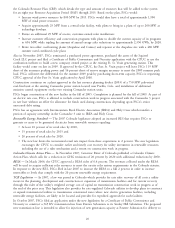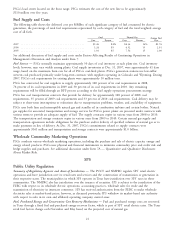Xcel Energy 2007 Annual Report Download - page 21
Download and view the complete annual report
Please find page 21 of the 2007 Xcel Energy annual report below. You can navigate through the pages in the report by either clicking on the pages listed below, or by using the keyword search tool below to find specific information within the annual report.
The FCA mechanisms allow NSP-Minnesota to bill customers for the cost of fuel and fuel related costs used to
generate electricity at its plants and energy purchased from other suppliers. In December 2006, the MPUC authorized
FCA recovery of all MISO Day 2 charges, except certain administrative charges, which NSP-Minnesota is partially
recovering in base rates and partially deferring for future recovery. In general, capacity costs are not recovered through
the FCA. NSP-Minnesota’s electric wholesale customers also have a FCA provision in their contracts.
NSP-Minnesota is required by Minnesota law to spend a minimum of 2 percent of Minnesota electric revenue on
conservation improvement programs. These costs are recovered through an annual cost recovery mechanism for electric
conservation and energy management program expenditures. NSP-Minnesota is required to request a new cost recovery
level annually. While this law will change to a savings-based requirement beginning in 2010, the costs of providing
qualified conservation improvement programs will continue to be recoverable through a rate adjustment mechanism.
MERP Rider Regulation — In December 2003, the MPUC approved NSP-Minnesota’s MERP proposal to convert two
coal-fueled electric generating plants to natural gas, and to install advanced pollution control equipment at a third
coal-fired plant. These improvements are expected to significantly reduce air emissions from these facilities, while
increasing the capacity at system peak by 300 MW. The first MERP project at the A. S. King plant went into service
in July 2007 with the remaining two projects (High Bridge and Riverside) expected to begin operations in 2008 and
2009, respectively, at a cumulative investment of approximately $1 billion. The MPUC approved a rate rider to recover
prudent costs of the projects from Minnesota customers beginning Jan. 1, 2006, including a rate of return on the
construction work in progress. The MPUC approval has a sliding ROE scale based on actual construction cost
compared with a target level of construction costs (based on an equity ratio of 48.5 percent and debt of 51.5 percent)
to incentivize NSP-Minnesota to control construction costs. At Dec. 31, 2007, the estimated ROE was 10.7 percent,
based on construction progress to date.
Actual Costs as a Percent of Target Costs ROE
Less than or equal to 75% ................................................ 11.47%
Over 75% and up through 85% ............................................ 11.22
Over 85% and up through 95% ............................................ 11.00
Over 95% and up through 105% ........................................... 10.86
Over 105% and up through 115% ........................................... 10.55
Over 115% and up through 125% ........................................... 10.22
Over 125% ......................................................... 9.97
Capacity and Demand
Uninterrupted system peak demand for the NSP System’s electric utility for each of the last three years and the forecast
for 2008, assuming normal weather, are listed below.
System Peak Demand (in MW)
2005 2006 2007 2008 Forecast
NSP System .............................. 9,104 9,859 9,427 9,737
The peak demand for the NSP System typically occurs in the summer. The 2007 system peak demand for the NSP
System occurred on July 26, 2007.
Energy Sources and Related Transmission Initiatives
NSP-Minnesota expects to use existing electric generating stations, power purchases, DSM options, new generation
facilities and phased expansion of existing generation at select power plants to meet its system capacity requirements.
Purchased Power — NSP-Minnesota has contractual arrangements to purchase power from other utilities and
independent power producers. Capacity is the measure of the rate at which a particular generating source produces
electricity. Energy is a measure of the amount of electricity produced from a particular generating source over a period
of time. Long-term purchase power contracts typically require a periodic payment to secure the capacity from a
particular generating source and a charge for the associated energy actually purchased from such generating source.
NSP-Minnesota also makes short-term purchases to replace generation from company-owned units that are unavailable
due to maintenance and unplanned outages, to comply with minimum availability requirements, to obtain energy at a
lower cost and for various other operating requirements.
Purchased Transmission Services — In addition to using their integrated transmission system, NSP-Minnesota and
NSP-Wisconsin have contractual arrangements with MISO and regional transmission service providers to deliver power
11


